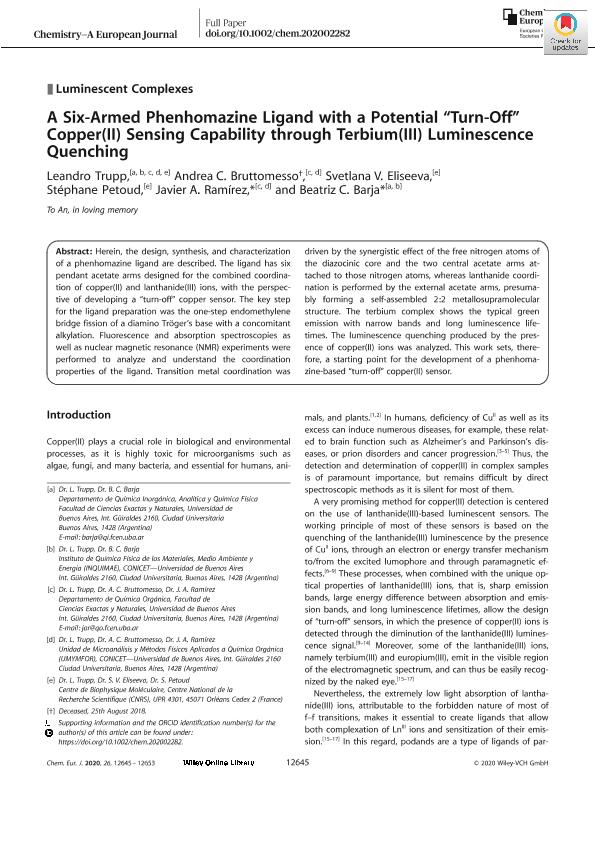Artículo
A Six-Armed Phenhomazine Ligand with a Potential “Turn-Off” Copper(II) Sensing Capability through Terbium(III) Luminescence Quenching
Trupp, Leandro Julián ; Bruttomesso, Andrea; Eliseeva, Svetlana V.; Petoud, Stéphane; Ramírez, Fernando Javier
; Bruttomesso, Andrea; Eliseeva, Svetlana V.; Petoud, Stéphane; Ramírez, Fernando Javier ; Barja, Beatriz Carmen
; Barja, Beatriz Carmen
 ; Bruttomesso, Andrea; Eliseeva, Svetlana V.; Petoud, Stéphane; Ramírez, Fernando Javier
; Bruttomesso, Andrea; Eliseeva, Svetlana V.; Petoud, Stéphane; Ramírez, Fernando Javier ; Barja, Beatriz Carmen
; Barja, Beatriz Carmen
Fecha de publicación:
10/2020
Editorial:
Wiley VCH Verlag
Revista:
Chemistry- A European Journal
ISSN:
0947-6539
Idioma:
Inglés
Tipo de recurso:
Artículo publicado
Clasificación temática:
Resumen
Herein, the design, synthesis, and characterization of a phenhomazine ligand are described. The ligand has six pendant acetate arms designed for the combined coordination of copper(II) and lanthanide(III) ions, with the perspective of developing a “turn-off” copper sensor. The key step for the ligand preparation was the one-step endomethylene bridge fission of a diamino Tröger's base with a concomitant alkylation. Fluorescence and absorption spectroscopies as well as nuclear magnetic resonance (NMR) experiments were performed to analyze and understand the coordination properties of the ligand. Transition metal coordination was driven by the synergistic effect of the free nitrogen atoms of the diazocinic core and the two central acetate arms attached to those nitrogen atoms, whereas lanthanide coordination is performed by the external acetate arms, presumably forming a self-assembled 2:2 metallosupramolecular structure. The terbium complex shows the typical green emission with narrow bands and long luminescence lifetimes. The luminescence quenching produced by the presence of copper(II) ions was analyzed. This work sets, therefore, a starting point for the development of a phenhomazine-based “turn-off” copper(II) sensor.
Palabras clave:
COPPER
,
LANTHANIDES
,
LUMINESCENCE
,
PHENHOMAZINES
,
SENSORS
Archivos asociados
Licencia
Identificadores
Colecciones
Articulos(INQUIMAE)
Articulos de INST.D/QUIM FIS D/L MATERIALES MEDIOAMB Y ENERGIA
Articulos de INST.D/QUIM FIS D/L MATERIALES MEDIOAMB Y ENERGIA
Articulos(UMYMFOR)
Articulos de UNID.MICROANAL.Y MET.FISICOS EN QUIM.ORG.(I)
Articulos de UNID.MICROANAL.Y MET.FISICOS EN QUIM.ORG.(I)
Citación
Trupp, Leandro Julián; Bruttomesso, Andrea; Eliseeva, Svetlana V.; Petoud, Stéphane; Ramírez, Fernando Javier; et al.; A Six-Armed Phenhomazine Ligand with a Potential “Turn-Off” Copper(II) Sensing Capability through Terbium(III) Luminescence Quenching; Wiley VCH Verlag; Chemistry- A European Journal; 26; 55; 10-2020; 12645-12653
Compartir
Altmétricas



